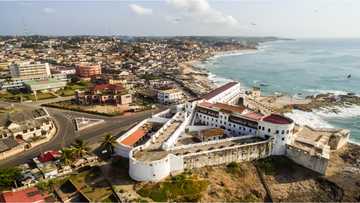Fante tribe: Culture, language, clans, food, traditional wear, facts
Fante tribe is the third-largest grouping of Akan people after the Ashantis and Akuapem. The Fante have always retained their state to this day even with the rapid growth of the Ashanti Empire during the historic times.

Source: UGC
What does Fante mean? Originally, the name Fante meant, the half that left. It was used to refer to the group of individuals who left and went to settle at Mankessim. The tribe is known for its distinct traditional clothing, food, and rich history.
History of the Fante tribe
Where did the Fante migrate from? They came from Techiman, in what is presently known as the northeastern Asante region. The tribe prevented the Portuguese arrived from infiltrating the inland after arriving in the 15th century.
The Portuguese were expelled when they objected to the rules and regulations set by Fante. Thereafter, the Dutch arrived, followed by the British. The Fante served as middlemen in the commerce between the interior and British and Dutch traders on the coast.

Read also
Tears flow as 6 victims of clash between illegal miners and soldiers at Obuasi laid to rest
The Fante debased Asante gold before selling it to the British and Dutch. They also controlled the flow of European firearms to the Asante. The tribe formed several autonomous kingdoms before joining the Fante confederacy. A bond was written in 1844 between the Fante and the British allowing the Gold Coast to gain independence without war one hundred years later.
In 1844 a bond was written between the Fante, and the British, allowing the Gold Coast to gain independence without war one hundred years later.
Fante tribe and slavery
From the beginning of the 18th century, the tribe gave out slaves to Dutch and British traders on the coast. In exchange, they were given firearms which they used in enforcing territorial expansion. In 1807, Osei Bonsu occupied southern Fante territory at Cape Coast.
During the same year, Great Britain outlawed the slave trade. A decline in trade relations caused a dispute over the Fante region for more than a decade. This led to warfare in the 1820s. The Fante defeated British force on 22nd January 1824 but made peace in 1831 and avoided conflict for the next 30 years.
READ ALSO: List of All Ethnic Groups in Ghana And Their Regions
Cultural and traditional aspects
Just like any other tribe, the Fante people have their own traditions and cultural practices which they observe to date. Fante culture and traditions are introduced to the kids as they grow up so that they can pass them over to the other generations. These aspects entail:
Traditional wear

Source: UGC
Since time immemorial, people distinguish the Fante tribe from other ethnicities by their culture, religion, and origin. However, another way of differentiating them is through their traditional wear. They wear different attires during different occasions taking place in the community. For instance, other than the day-to-day normal attire, they have attires that are specifically designed for certain events.
Some of the common traditional Fante wear are:
- Kuntunkuni
- Kobene,
- Adinkra
- Kogyan
- Nkrawo abotire
- A yellow or red loincloth
- Necklaces of seeds
- Tiny snail shells
- Hide
- Wreaths of leaves
- Straw bands
- Native or rubber sandals
- black and red body painting
READ ALSO: Ga-Adangbe tribe: language, traditional wear, dances, food, religion
Language
The Fante language is one of the three primary members of the Akan dialect together with Akaupem and Asante. Is Fante a Twi language? Fante is not a Twi language. Asante and Akuapem are collectively known as Twi.
Fante is the common dialect of the Fante people, whose communities have their own sub-dialects. They include Agona, Anomabo, Abura, and Gomoa, all of which are mutually intelligible. The standardized form of Fante is taught in both primary and secondary schools. A majority of the Fantes are bilingual or bidialectal and most of them can speak Twi.
Traditional food

Source: UGC
Women from the Fante tribe are highly-skilled in preparing different types of traditional Fante food. The main dishes are prepared around a starchy staple food accompanied by sauce or soup which is the source of protein in the meal.
The main staple foods are made with:
- Maize - Banku, akple, mmore, dokonu, fonfom and tuo zaafi
- Rice- Omo Tuo, Waakye, plain rice, jollof rice, fried rice, angwa moo and ngwo moo
- Cassava - Kokonte, fufuo, gari, plakali, and attieke
- Yam - Yam fufuo, ampesie and mpotompoto
- Beans
Religion
Fante people believe in the presence of a supreme god. Fante religion claims that at one time the god freely interacted with man. However, after being constantly struck by the pestle of an old woman pounding fufu, he moved far up into the sky. There are no priests that serve him directly.
Therefore, people are at liberty to make direct contact with him. Several other gods receive their power from the supreme god and are connected to the natural world. These gods include the ocean, rivers, spirits, and various local deities.
Priests serve individual spirits and act as the mediators between gods and humankind. Almost every person takes part in the daily prayer which entails pouring of libations as an offering to both the ancestors and to the spirits. The earth is seen as a female deity who has a direct connection to fertility and fecundity.
Clans and lineage
The head of each Fante state is the paramount chief who is chosen from the royal lineage. Under him are divisional chiefs and subchiefs. The chiefs are representatives of the asafo and they act as advisers to the paramount chief.
The Fante clans have a dual lineage system, matrilineal descent, and patrilineal descents. Matrilineal descent determines membership in clans and their localized segments. Each lineage has a ceremonial stool resided by important ancestral spirits. Worship is a prominent feature of Fante religion.
Patrilineal descent governs the inheritance of spiritual attributes. It also determines membership in the asafo military organization. The functions of the asafo are political, social, religious, and military.
READ ALSO: Guan tribe: history, language, food, dance, festivals, facts
Festival

Source: UGC
The Fante tribe holds an annual festival known as the Ahobaa. It dates back to the Fetu kingdom of the 17th century. The climax of the celebration takes place on the first Saturday of September each year. During this final day, everyone wears an orange dress and send gifts in orange colours.
Ahobaa is a week-long celebration that comes after the harvest season. Its main purpose is to give thanks to the spirits of Fetu religion for:
- Plentiful catch from the sea
- The fruits of the earth
- Guidance and protection in the past year
The Fante tribe is one of the ethnic groups from West Africa which is popularly known for its rich and vibrant culture. They take their culture seriously and do everything that was set in place by their forefathers to ensure it is passed over to all generations.
READ ALSO: Hausa: history, culture, traditions, dressing, food, interesting facts
Yen.com.gh recently shared the history, culture, traditions, dressing, food, interesting facts of the Hausa. They are the largest ethnic group in Sub-Saharan Africa. While many of them settled in Northern Nigeria, a majority are also in adjoining south-eastern parts of Niger.
The Hausa are an ethnic group found in northern Nigeria and southern Niger. They are predominantly Muslims but a few of them believe in a spirit-possession cult. Like other ethnicities, the Hausa also have rites of passage and distinguish themselves from others by the types of clothes they wear.
READ ALSO:
- Dagomba tribe: history, food, language, traditional dress, dance, facts
- Ashanti culture, language, religion, food, rites, clothing, facts
Source: YEN.com.gh







